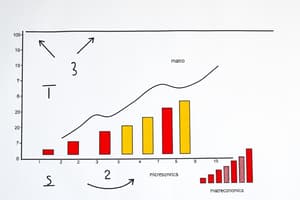Podcast
Questions and Answers
What is the primary focus of microeconomics?
What is the primary focus of microeconomics?
- Individual agents and their decision-making processes (correct)
- The entire economy and national income
- Global market trends and trade
- Government policies and taxation
What does the term 'scarcity' refer to in economics?
What does the term 'scarcity' refer to in economics?
- The effects of inflation on purchasing power
- The unlimited wants and limited resources available (correct)
- The abundance of resources in an economy
- The trade-off between different resources
Which of the following best defines opportunity cost?
Which of the following best defines opportunity cost?
- The cost of producing one more unit of a good
- The expenses incurred during a financial transaction
- The cost of selecting one option over the next best alternative (correct)
- The total income that could be earned without spending
What characterizes a monopoly in the market structure?
What characterizes a monopoly in the market structure?
Which indicator measures the total value of goods and services produced in a country during a specific period?
Which indicator measures the total value of goods and services produced in a country during a specific period?
How does fiscal policy primarily influence the economy?
How does fiscal policy primarily influence the economy?
What is a key characteristic of a command economy?
What is a key characteristic of a command economy?
What process occurs when supply equals demand in a market?
What process occurs when supply equals demand in a market?
Flashcards are hidden until you start studying
Study Notes
Key Concepts in Economics
-
Definition
- Economics is the study of how individuals and societies allocate scarce resources to satisfy unlimited wants.
-
Branches of Economics
- Microeconomics
- Focuses on individual agents (consumers and firms) and their decision-making processes.
- Examines supply and demand, price formation, and market structures.
- Macroeconomics
- Studies the economy as a whole, including national income, overall levels of prices, and economic growth.
- Analyzes aggregate indicators such as GDP, unemployment rates, and inflation.
- Microeconomics
-
Basic Economic Principles
- Scarcity
- Resources are limited while human wants are unlimited, leading to the need for choice.
- Opportunity Cost
- The cost of forgoing the next best alternative when making a decision.
- Supply and Demand
- Demand: Quantity of a good or service consumers are willing to buy at different prices.
- Supply: Quantity of a good or service producers are willing to sell at different prices.
- Equilibrium: The point where supply equals demand.
- Scarcity
-
Market Structures
- Perfect Competition
- Many buyers and sellers, identical products, easy entry and exit.
- Monopoly
- Single seller controls the market, unique product, high barriers to entry.
- Oligopoly
- Few sellers dominate the market, products may be identical or differentiated.
- Monopolistic Competition
- Many sellers with differentiated products, some control over prices.
- Perfect Competition
-
Economic Indicators
- Gross Domestic Product (GDP)
- Total value of all goods and services produced within a country in a specific period.
- Unemployment Rate
- Percentage of the labor force that is jobless and actively seeking employment.
- Inflation Rate
- Rate at which the general level of prices for goods and services rises, eroding purchasing power.
- Gross Domestic Product (GDP)
-
Fiscal and Monetary Policy
- Fiscal Policy
- Government expenditure and tax policies to influence the economy.
- Tools: Government spending and taxation.
- Monetary Policy
- Central bank actions to control the money supply and interest rates.
- Tools: Open market operations, discount rate, and reserve requirements.
- Fiscal Policy
-
Types of Economies
- Traditional Economy
- Based on customs and traditions, often agricultural and subsistence-based.
- Command Economy
- Central authority makes all economic decisions (e.g., socialism).
- Market Economy
- Decisions are made by individuals based on supply and demand (e.g., capitalism).
- Mixed Economy
- Combines elements of market and command economies.
- Traditional Economy
-
International Economics
- Trade
- Exchange of goods and services between countries.
- Benefits include comparative advantage and specialization.
- Exchange Rates
- The value of one currency for the purpose of conversion to another.
- Balance of Payments
- A record of all economic transactions between residents of a country and the rest of the world.
- Trade
These notes cover fundamental aspects of economics, providing a solid foundation for further study or revision.
Definition of Economics
- Study of allocation of scarce resources to fulfill unlimited human wants.
Branches of Economics
-
Microeconomics
- Analyzes individual agents like consumers and firms.
- Focuses on supply and demand, price formation, and market structures.
-
Macroeconomics
- Investigates the economy as a whole.
- Studies national income, price levels, and economic growth using aggregate indicators like GDP, unemployment rates, and inflation.
Basic Economic Principles
-
Scarcity
- Natural limitation of resources in contrast to limitless human wants creates the necessity for choices.
-
Opportunity Cost
- Represents the cost incurred by choosing one alternative over another.
-
Supply and Demand
-
Demand
- Represents the quantity consumers are willing to purchase at varying prices.
-
Supply
- Indicates how much producers are willing to sell at different prices.
-
Equilibrium
- A state where supply meets demand, stabilizing the market.
-
Market Structures
-
Perfect Competition
- Characterized by many buyers and sellers, identical products, and easy market entry and exit.
-
Monopoly
- One seller dominates with a unique product and high entry barriers.
-
Oligopoly
- Few sellers control a significant market share, offering either identical or differentiated products.
-
Monopolistic Competition
- Many sellers provide differentiated products, allowing some price control.
Economic Indicators
-
Gross Domestic Product (GDP)
- Measures total value of goods and services produced within a country over a specific timeframe.
-
Unemployment Rate
- Percentage of the labor force currently jobless and seeking employment.
-
Inflation Rate
- Indicates the rate at which overall prices for goods and services increase, decreasing purchasing power.
Fiscal and Monetary Policy
-
Fiscal Policy
- Refers to government spending and tax strategies aimed at influencing economic conditions.
-
Monetary Policy
- Encompasses central bank strategies to manage the money supply and interest rates.
- Key tools include open market operations, discount rate adjustments, and reserve requirements.
Types of Economies
-
Traditional Economy
- Grounded in customs and traditions, primarily agricultural and subsistence-focused.
-
Command Economy
- Economic decisions are centrally made by authorities (e.g., socialism).
-
Market Economy
- Decisions are dictated by individuals based on supply and demand principles (e.g., capitalism).
-
Mixed Economy
- Integrates elements of both market and command economic systems.
International Economics
-
Trade
- Involves the exchange of goods and services internationally with advantages like comparative advantage and specialization.
-
Exchange Rates
- Reflect the value of one currency converted to another, impacting international trade.
-
Balance of Payments
- Chronicles all economic transactions between a country’s residents and the global economy.
Studying That Suits You
Use AI to generate personalized quizzes and flashcards to suit your learning preferences.




